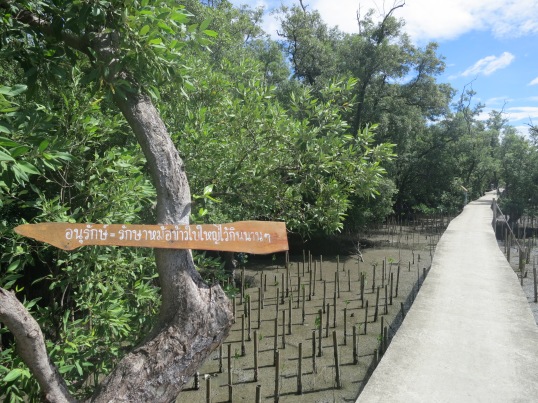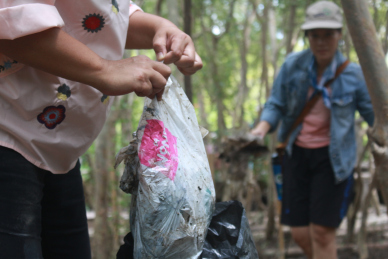Planting the Roots of Teamwork in the Mangroves
“If survival is an art, then mangroves are artists of the beautiful,” wrote Annie Dillard while ruminating on what mangrove trees can teach us about human’s fleeting search for meaning. For Dillard it was “[N]ot only that they exist at all – smooth-barked, glossy-leaved, thickets of lapped mystery,” but also that this existence is a home, a cohort of dependent living organisms where “they can and do exist as floating islands, as trees upright and loose, alive and homeless on the water.” These thoughts settled in the back of my head as I watched my colleagues from RECOFTC – The Center for People and Forests move through the thick, life-sustaining mud of the “Mangrove Natural School” in Bang Bor Lang Village, Samut Songkham Province, Thailand as part of RECOFTC’s annual team-building exercise.
Yet Dillard, despite her poetic beauty, overlooked an aspect that local communities understand so thoroughly: the tangible benefits that mangroves have on sustaining livelihoods, protecting communities from natural disasters, mitigating climate change, and securing biodiversity in ecologically vital areas. Sure, it is true that mangroves can provide a relief from existential dread, but at the same time they provide more substantial relief through their impact on everyday life. 
According to the Center for International Forestry Research (CIFOR), Mangroves in Indonesia store more than five times the carbon of upland forests. The result is massive for climate change mitigation at the global and regional level. On a more localized level, however, mangroves have complex root systems that provide suitable conditions for a vast array of fish and other organism. These ecosystems thus provide a sustainable and healthy means of livelihood production through several food products, “including honey, algae, fruit, salt, and leaves for livestock,” according to the Global Mangrove Alliance. But in Thailand, and throughout the Asia – Pacific, these mangroves have acted as life-affirming agents as well, providing protection from increasingly deadly natural disasters. As Visoot Nuamsiri, the former village chief Bang Bor Lang, described during our visit, several communities survived the tsunami in 2004 because they lived behind mangrove forests that helped lessen the storm’s brutal impacts.
Yet, unfortunately, the rising temperatures are creating visible effects, a point repeatedly stressed by the community members. The Asia – Pacific is already losing mangroves at twice the rate of other regions, with 250,000 ha lost between 2000 and 2012. And in this particular community, the statistics would make any expert, local or international, nervous if it wasn’t for the presence of the community members. Without their support and monitoring, only one mangrove seedling would survive for every 300 planted.
Nonetheless, the communities have found innovative ways to persist, including the use of bamboo fences to reduce the strong energy of the waves and trap sediments, as well as the creation of an intricate monitoring policy. As previously mentioned, through the dedicated work of community members, the results have improved. Bounyadeth Phouangmala, country program director for Lao PDR, reflected on this during a debriefing. “We learned from the communities. They are smart and do great work, often times with better ideas than us.”
 And in this reflection lies the point of pursuing team building activities in the field. Although the majority of RECOFTC’s staff work alongside local communities, there are, as Jonas Dahlstrom noted, a few “of us [who] are based in offices, and we can’t experience forests through our laptops.” This, reiterates the importance of connecting the reality on the ground with the work conducted in the office. It allows certain staff members to learn through doing, practice what we preach, and question our own assumptions. As Dy Vutheara from Cambodia Country Program said, “It is important to practice the theory, because it really showed [us] the way we plant mangroves,” and reinforced the labor intensive practices that often go into conservation and livelihood production. By engaging with the local communities and participating in the technical planting of mangroves and the collection of trash, we were able to realize the deep connection found between the interlocked branches of the mangroves.
And in this reflection lies the point of pursuing team building activities in the field. Although the majority of RECOFTC’s staff work alongside local communities, there are, as Jonas Dahlstrom noted, a few “of us [who] are based in offices, and we can’t experience forests through our laptops.” This, reiterates the importance of connecting the reality on the ground with the work conducted in the office. It allows certain staff members to learn through doing, practice what we preach, and question our own assumptions. As Dy Vutheara from Cambodia Country Program said, “It is important to practice the theory, because it really showed [us] the way we plant mangroves,” and reinforced the labor intensive practices that often go into conservation and livelihood production. By engaging with the local communities and participating in the technical planting of mangroves and the collection of trash, we were able to realize the deep connection found between the interlocked branches of the mangroves.
But how did we seek to achieve such lofty goals?
Transferring the experience to the staff began with a detailed presentation by Visoot Nuamsiri and other community members who described the importance of mangroves to the local community. This conversation was then put into competitive practice. Each team, of which there were six, split up their members to pursue two goals: plant fifty mangrove seedlings and pick up as much trash as possible.
Additionally, each team had to be cognizant of their communication abilities and team spirit while completing each task. Yet, this came with its fair share of challenges. Nonette, an intern from Indonesia Country Program, understood this and was able to overcome these challenges through the use of a “universal language,” such as body language and smiles, to navigate the language barrier between team members and the community. The pictures that were captured clearly showed the reciprocal joy generated through these common understandings.
Overall the team building plan worked. Being knee deep in the mud, contributing to the continued growth of these prehistoric ecosystems, blurred our competitive nature; the positive effects of mangroves reverberated throughout the day. Instead of being members of specific countries or members of specific units, we came closer while working alongside the community members, reinforcing our vision and mission through participatory action.

As one member of the red team succinctly stated, the results were humbling: “It isn’t only about one color, we had to work across teams.” Continuing to stress the theme of the day, he then summed up our activities with the follow slogan:
“Teamwork makes the dream work.”

